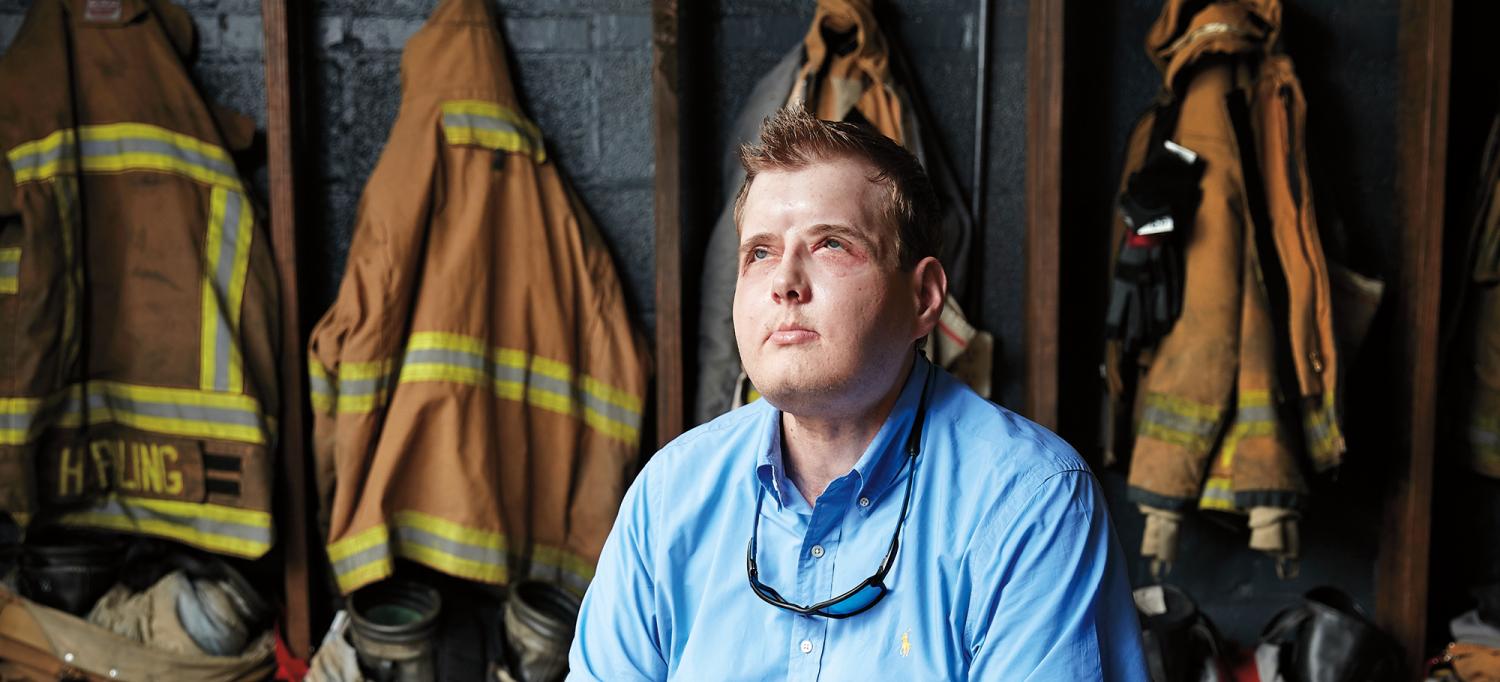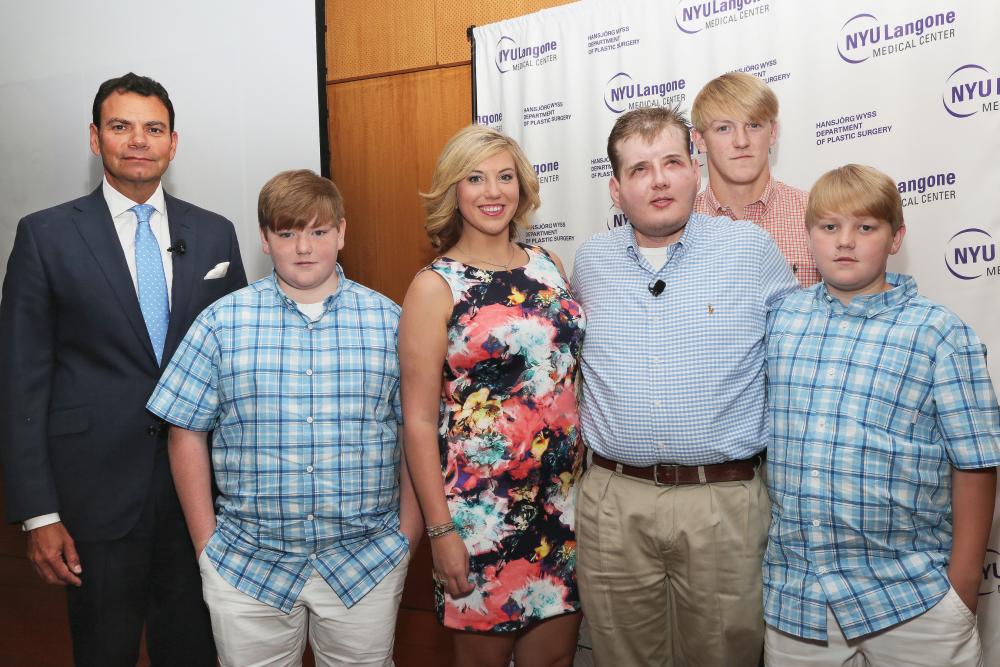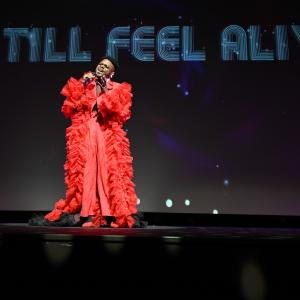
Patrick Hardison, in the firehouse where he was a volunteer firefighter for seven years before his injury.
Photo: Ben Rollins
Patrick Hardison, the 42-year-old volunteer firefighter who made medical history at NYU Langone last year when he successfully underwent the most extensive face transplant ever performed, formally introduced himself to the media—and to the world—in August. He was the guest of honor at a press conference held at NYU Langone to mark the one-year anniversary of his pioneering surgery. Hardison, a father of five, was severely burned in the line of duty in 2001 in his hometown of Senatobia, Mississippi.
Eduardo D. Rodriguez, MD, DDS, the surgeon who led a team of more than 100 medical professionals who collaborated on the procedure, reported that Hardison is thriving. He can form a full range of facial expressions, chew without pain, and articulate clearly. Not only can he fully close his eyes for the first time since the accident, but his ability to blink has been restored, keeping his eyes clean and hydrated so that he’s no longer at risk of going blind. “We are amazed at Patrick’s recovery, which has surpassed all of our expectations,” says Dr. Rodriguez, the Helen L. Kimmel Professor of Reconstructive Plastic Surgery and chair of the Hansjörg Wyss Department of Plastic Surgery. “Most significant is the lack of a rejection episode. We believe this has much to do with the methodical approach we took in the matching process to ensure that Patrick’s donor provided the most favorable match.”
Hardison’s extraordinary recovery—unique among the 37 face transplants previously performed—has allowed his medical team to move forward with the removal of his abdominal feeding tube and the breathing tube in his trachea much sooner than expected. Now that Hardison’s facial swelling has largely subsided, Dr. Rodriguez has been able to perform revisions to his forehead, eyes, lips, chin, and ears. “Patrick is extremely committed to regular exercise, complying with his medication regimen, and meeting with his physicians regularly,” notes Dr. Rodriguez. “This puts him way ahead of schedule in terms of achieving the optimal level of recovery and appearance.”
During a recent visit to New York, Hardison shared his reflections on the most transformative year of his life.
A Bond Like No Other
“Once I met Dr. Rodriguez, I knew he was the guy. We just had a connection. He said, ‘This is what’s going on. You and I are family. We’re hooked for life.’ And he’s been straight up with me the whole time. Dr. Rodriguez and his team have been very supportive. I had a lot going on in my head, but he helped me work through it all. After the transplant, I would call Dr. Rodriguez, and he would come to my hospital room within minutes. I never had any doubts that it would go well. From the first time I met Dr. Rodriguez, he was determined that this was going to be a success. I’m so grateful to him and the entire transplant team for the new face they gave me.”
Highs and Lows
“After my accident, it was very tough. Every day I was thinking, ‘If I can just make it through this day without the stares and the questions.’ It was like that for 14 years, but now I don’t have to do that. Now I’m just a normal guy walking down the street. It’s such a great feeling. I’m so much happier. My energy level is good, so I’m able to do whatever I want to do. My two sons live with me, and we spend as much time together as we can. We’ve taken some small trips out of town and a big trip to Disney World. I enjoy the simple stuff: sitting down to dinner with my kids, going fishing with them, having friends over, hanging out with my buddies at the firehouse.
“After the transplant surgery, I tried to stay focused on healing and maintaining a positive outlook. I remember when I thought my life was over. I used to say to myself, ‘When my daughters get married, I’ll just wear my cap and dark glasses.’ But I prayed on it heavily for years. I prayed for change, and then this wonderful thing happened. When I look into the eyes of my kids, I see happiness—because they see how happy I am. My favorite memory of the past year is when all of my kids came to New York to visit me at NYU Langone after the transplant. I hadn’t seen them in a while, and I was really missing them. It gave me a little extra boost.”
A Joyful Homecoming
“It was great to finally go home to Senatobia after the surgery. The first thing I did was have a glass of sweet tea. It’s a Southern thing—you can’t get it in New York. The entire town greeted me. The streets were lined up with cars and people. Many of them came to the house and welcomed me home. It really got my spirits up.
“I’ve tried to get back to my routine. The biggest adjustment is just learning to live with a new face. I walk up to people and ask them, ‘Do you know who I am?’ They say, ‘No, I guess I don’t.’ So I tell them, and they’re just stunned. Oddly enough, when I’m in New York, some people actually recognize me. They’ll come up to me and say, ‘Hey, you’re the guy on the news?’ And I’ll say, ‘Yes, sir, I am.’ ”
A Miracle of Modern Medicine—and Faith
“Some people who hear about my story tweet me. They say things like ‘I thought I had a big problem, but once I learned what a courageous person you are, I don’t even acknowledge my own problems anymore.’ But I don’t like to be classified as a hero, and I don’t see myself that way. I’m the same person I’ve always been. I still have the same friends. I still do the same things. I’m just Pat—and I’ll always be Pat. I had an accident doing what I loved, and this was the outcome. You’ve got to take the good with the bad. If I could go back, I would still go into that burning house. I was angry for years, but now I see this for what it is—a miracle. God has kept me on this earth this long to get this transplant, so that I can inspire others, so that I can give them hope.”
Facing the Future
“Now that I can blink again, I sleep better than I have in years—usually six or seven hours. It’s just like it was before the accident. My eyes are never dry, so I can tell they’re doing a good job. This means I can drive again, and that’s a big deal for me. For so long, I had to depend on others to get around.
“Dr. Rodriguez says that in another six months, when more of the swelling goes down, I’ll look totally different. Hopefully, I’ll get to a place one day where I can do some motivational speaking. I’d like to share my story with wounded warriors or injured firefighters and police officers. I want to encourage others who need a face transplant. The rewards are way bigger than the risks.
“I recently met the donor’s mother. I wanted her to know that her son is still living in me and in those who received his other organs. It was great to meet her and thank her. She gave me a new life.”



